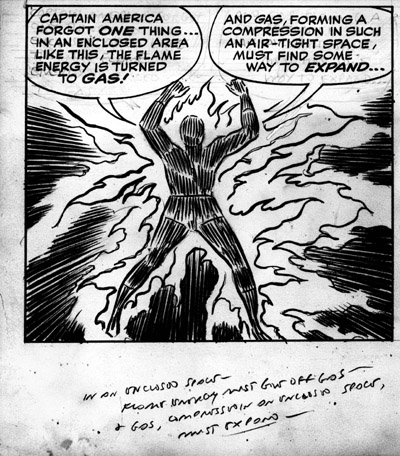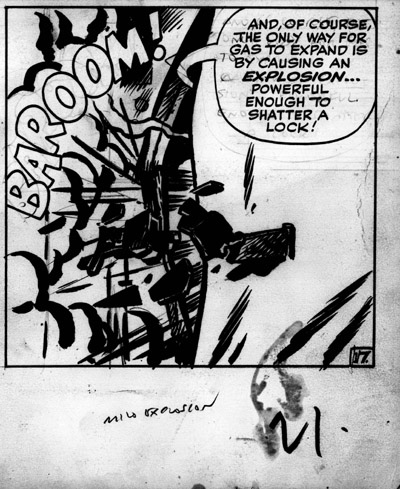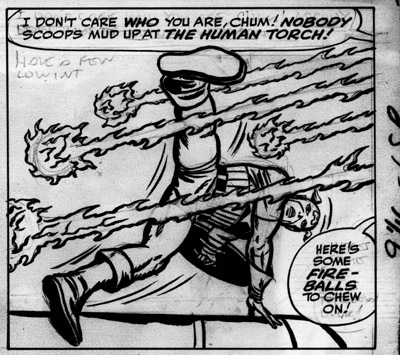I warned you that I would be posting on subjects outside of the Simon & Kirby time period. In this post I want to discuss another great collaboration, that of Stan Lee and Jack Kirby.
While examining some original Kirby art from my collection, Nick Caputo once commented that some of the margin notes were not done by Jack as I had assumed. Some were in Stan Lee’s handwriting. Only after the visit did I realize that I had not taken any notes and was no longer sure exactly which margin notes Nick was referring to. By email Nick kindly agreed to examine scans to help sort it all out. He has also given me permission to quote some of his correspondence here.
When I prepared the scans I decided to make some adjustments in Photoshop to bring out the pencils. I noticed that if I adjusted the contrast really high not only did the margin notes become stronger, but I could also more easily see pencils that had been erased.
Here I will discuss pages 5 and 21 from Strange Tales #114 which had a cover date of November 1963. Inking was by Dick Ayers and what a great job he did. His brush work is powerful and confident. I don’t think there is any use of white-out to correct any of his inking. These pages are very special to me as I remember how excited I was when the comic came. I was too young to know anything about Cap’s previous appearances, but something about him made me an immediate fan. This despite the fact that in this story he turns out to actually be the Acrobat. For me this, not Avengers #4, has always been the first Silver Age appearance of Cap.
Besides the margin notes, there are erased notes inside the balloons. The balloon notes seem to match the inked version of the text. For example from page 5 panel 1:

Nick commented to me:
A close look at the lettering tells me that its Stan’s writing in the balloons. My guess is Stan put those words in after Kirby penciled the pages but before they were inked. This may have been how Stan worked, perhaps doing away with a script and writing the copy directly on the pages for the letterer to copy…
Unfortunately most of the margin notes on the sides have been trimmed during production. But those on the bottom happily remain. Such as below panel 5 on page 21.

Nick remarked
Yep, that’s Stan’s sloppy handwriting. I can read some of it “In an enclosed space…” changed a bit from the copy, but close enough, making me believe more and more that this was Stan’s shorthand, giving him a rough idea of what he would later dialogue in the word balloons.
In case you have trouble reading the Stan’s sloppy handwriting, I believe the margin notes reads:
In an enclosed space, flame energy must give off gas and gas, compressed in an enclosed space, must expand

Under panel 6 (see above) on the same page is a note that reads “mild explosion”. I admit I was a bit puzzled by this note now that Nick identified it as from Lee. Why would he have to write that if Kirby had already penciled the panel? I think the answer is that if you imagine what it looked like without the balloon text and the “BAROOM” it probably was not very clear what was going on.

On page 5 panel 4 Stan writes just below the upper balloon. Although I could make the first line of it out, the second line escaped me. But Nick suggested it reads “Have a few low int(ensity)” referring to the fireballs. Probably having written that much, Stan realized that he did not have enough room in the upper balloon. When he added the lower balloon he had already decided to change the text a bit.
I think Nick is correct that for these pages Stan used the margins to rough out his ideas and then use the balloons to write the finalized version. But if this is true, then the Marvel Method was in effect at this time. Why would Stan have to rough out his ideas if Kirby was working from a script? But although the Marvel Method was being used, Jack had not yet developed his habit of writing his own notes in the margins. I can see that the technique Lee used on these pages worked well for him. But I suspect it made life a bit more difficult for the letterer. Although Lee wrote the balloon text in a much more legible manner then the margin notes, it still was only a rough placement. Someone would either have to recopy the text, or the letterer would be faced with problem of inking over the very text he was working from.


As I may have mentioned elsewhere, I believe Lee’s work method evolved with time. He stopped writing directly on the pages when he became involved in writing most of the titles and initiaiting Heck and Ayers into working from a short synopsis (either written or verbal). He then left it up to the artists to make notes in the margins to remind him of what was going on, and the artists would add other bits of business that were probably not in the synopsis. Later on, just about all the artists (Romita, Colan, Buscema, Roth, Everett) would work in this manner.
Nick Caputo